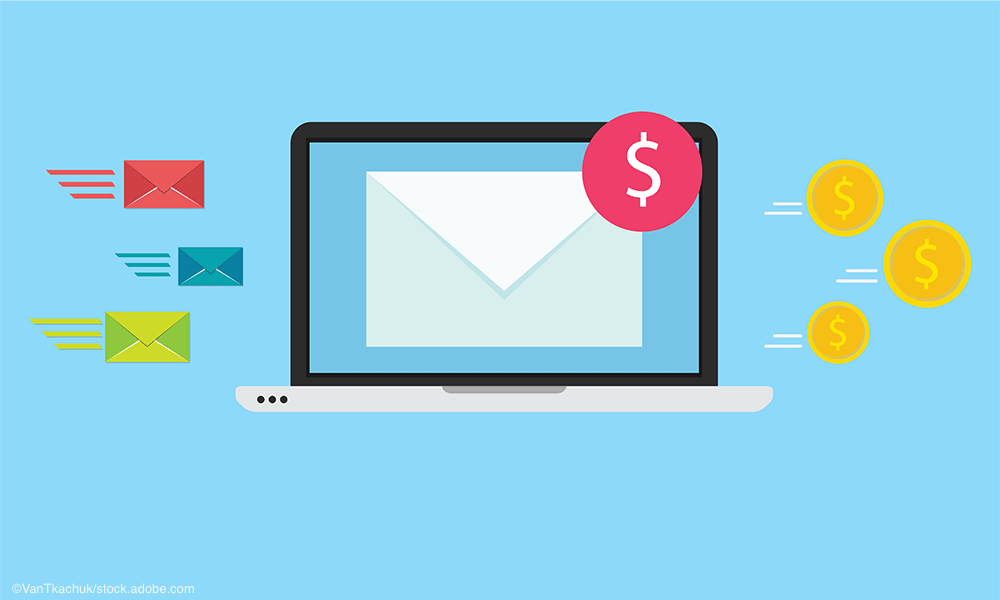How email marketing can help collect delinquent medical payments
A fast and cost-efficient way to inform people about what they owe.

Health insurance deductibles are on the rise. Providers are struggling to get reimbursed because high out-of-pocket spends are hard to collect. In an athenahealth study, providers who saw commercially insured patients collected just 12% of what they were owed at the time of service, and in two out of three visits they collected nothing upfront at all.
How email can help
Sending HIPAA compliant email to patients about their medical bills is a fast and cost-efficient way to inform people about what they owe. A common challenge to mailing paper bills is patients who have relocated without providing a new address. People keep the same email address for years, so your messages will continue to reach clients even if they have relocated.
With HIPAA compliant email marketing, you can instantly send bulk email to everyone with delinquent accounts for faster results. This saves money on postage and paper supplies.
Trending: The AI Difference in Revenue Cycle Management
Use all the tools available to you
You can use a combination of channels to communicate with patients about their balances. You can continue to send paper bills and call patients while adding email marketing as an additional touchpoint.
For example, you could send patients emails about their bill and/or mail them an invoice before the payment is due, then continue to follow up by voicemail, email, and regular mail—as many methods as possible—if the payment has not been received.
Share detailed cost information and payment options
Be sure to put your policies in writing and provide a financial obligation estimate ahead of time. Inform patients about payment expectations in your appointment confirmation and reminder emails. To lower the chances your patients will end up with medical bills they can’t afford, be as upfront as possible about procedure costs.
According to MedData research, 62% of patients said knowing their out-of-pocket expenses in advance of service impacts the likelihood of pursuing care. Having clear information from a doctor on the expected out-of-pocket costs before receiving treatment impacts 49% of respondents’ decision to choose a healthcare provider.
In other words, it benefits both you and your patients to be up front about medical costs. Patients will go into the treatment with eyes wide open which will help them avoid accruing bills they cannot pay. They also may be more likely to choose you for a treatment if you provide clear information while your competitors do not.
Explain your bill in detail
Oftentimes patients are presented with bills that don’t include a detailed explanation of what they are paying for. When patients don’t understand their bills, they may simply choose not to pay them or delay paying them because they don’t have the time to figure it out.
To counteract this behavior, educate your patients about the cost of care in plain English in your emails before and after a procedure.
Provide better customer service with email
Today’s patients are looking for quality service at every touch point of their medical journey. And they love to be asked about their opinion.
You could email a survey seeking feedback about a patient’s experience along with a payment request. When patients feel that their voices are being heard, they’re more likely to make timely payments.
Keep open lines of communication
You want to provide every chance for patients to reach out to you if they are having trouble paying. This is yet another reason why multiple methods of communication—email, mail, phone, — are useful before and after treatment.
Offer a payment plan
Patients are often already worried about their medical condition, and having fears about making a payment adds to their stress.
Be kind in your email messaging and let patients know that your practice understands their financial burdens. Then steer the conversation to discuss your various payment plan options.
Read More: Untangling telehealth billing
Use a collection agency as a last resort
After exhausting all other options, you may have to advise patients that you will send them to collections. Be sure to include a dollar amount and time limit for referring past-due bills to a collection agency in any emails you send.
Healthcare entities should be cautious when it comes to recovering debt for medical bills and not pursue debtors too aggressively, which can easily happen when an outside company is handling your collections.
All the more reason to keep your patient balances from ever getting to the point where aggressive collection efforts are necessary.
Conclusion
If you and your staff maintain good relationships with your patients and provide high-quality care, patients will be more motivated to pay on time. Your medical facility should do everything it can to make it easy for people to get in touch with you, optimize transparency, and offer multiple payment options.
HIPAA compliant email and email marketing are two weapons you should consider adding to your arsenal of tools you have at your disposal for collecting payments.